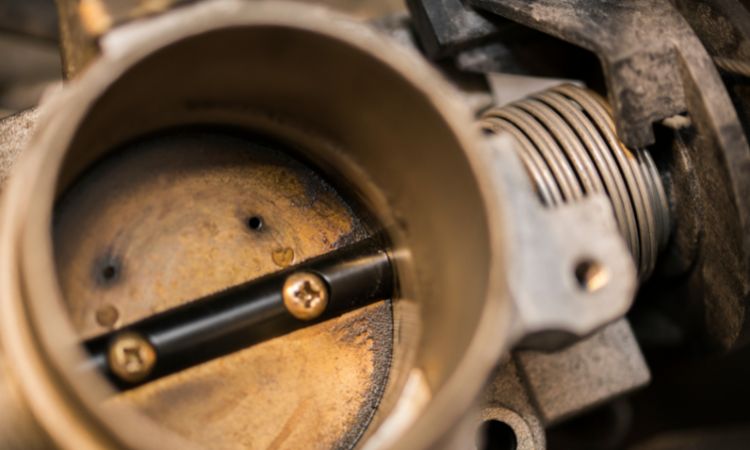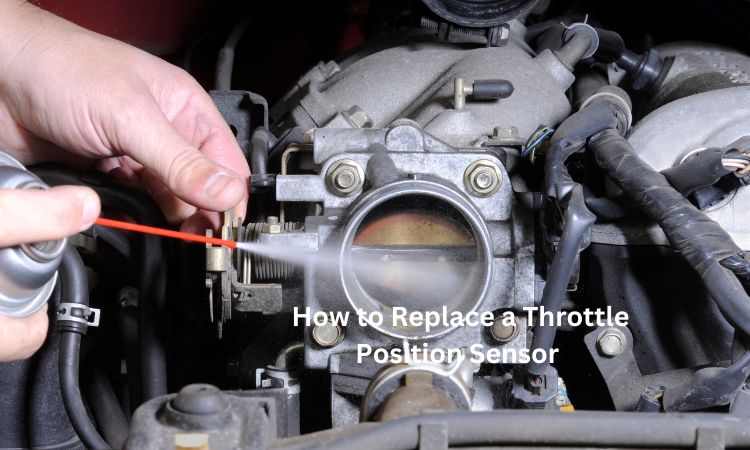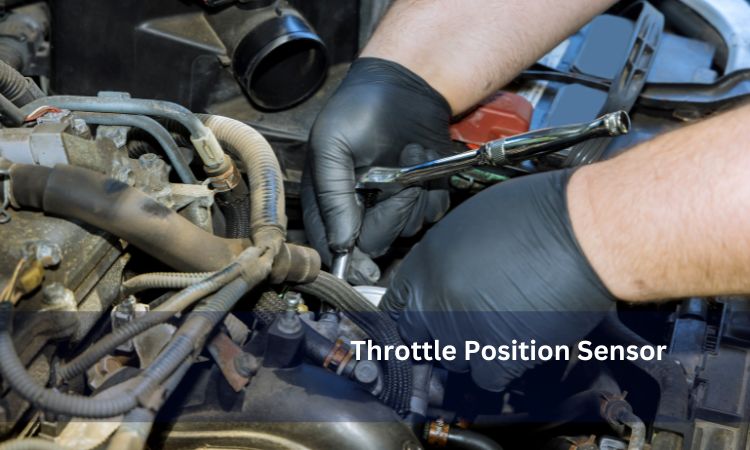How to Reset Throttle Position Sensor Ford
The throttle position sensor is located on the right side of the engine near the throttle body. It is a small, black box with two wires coming out of it. The purpose of the throttle position sensor is to measure how far open the throttle plate is.
When you depress the accelerator pedal, the throttle plate opens and allows more air into the engine. The TPS measures this change in position and sends a signal to the computer telling it how much fuel to inject. If your vehicle is having issues with idling or accelerating, it could be a sign that your Throttle Position Sensor (TPS) needs to be reset.
In order to reset your TPS, you will need to disconnect the battery for 30 seconds and then reconnect it. Once you have done this, start up your car and let it idle for a few minutes before driving off as normal. If your TPS was indeed causing problems, you should notice an improvement in performance immediately.
- First, disconnect the battery’s negative cable to prevent any electrical shorts
- Next, locate the throttle position sensor (TPS) on the throttle body
- It is usually mounted on or near the top of the throttle body
- Once you have found the TPS, use a small flathead screwdriver to loosen and remove the two screws that hold it in place
- Carefully pull out the old TPS and unplug the electrical connector from it
- Install the new TPS in its place and tighten down the two screws holding it in place with your screwdriver
- Plug in the electrical connector to the new TPS unit and then reconnect your battery’s negative cable
How Do You Reset a Throttle Position Sensor?
When it comes to resetting a throttle position sensor, the process can vary depending on the type of sensor you have. For example, many newer vehicles have what’s called a “drive-by-wire” throttle system, which means there is no physical connection between the accelerator pedal and the throttle body. Instead, an electronic signal is sent from the pedal to the engine control unit (ECU), which then activates a motor that opens or closes the throttle valve.
If your vehicle has this type of system, then it’s likely that there is no way to physically reset the sensor. However, you may be able to do a software reset by disconnecting and reconnecting the battery, or by using a scan tool to clear any stored codes in the ECU. On older vehicles with a cable-operated throttle system, there is usually a physical TPS sensor mounted on or near the throttle body.
This type of sensor can often be reset simply by disconnecting and reconnecting the battery. However, if your vehicle has an electronic TPS (which is becoming more common), then you will need to use a scan tool to perform a software reset.
How To Reset The Throttle Position Sensor In A Ford, Symptoms of a Bad TPS
How Do You Calibrate a Ford Tps Sensor?
If you have a Ford vehicle from the 1990s with electronic fuel injection, then it likely has a throttle position sensor (TPS) on the throttle body. The TPS is used to monitor the position of the throttle butterfly valve and sends a signal to the engine control unit (ECU) indicating how much throttle input is being applied by the driver. The ECU can then adjust fueling and ignition timing accordingly.
If your vehicle is running rough or the idle is unstable, one possible cause is a faulty TPS sensor. The good news is that the calibration of a TPS sensor is relatively easy and can be done at home with some basic tools. First, check your vehicle’s service manual for the specific procedure as there may be slight variations depending on model year and engine type.
Then, gather together a digital multimeter, an assistant, and some patience! With the engine off, disconnect the negative battery terminal to prevent any accidental shorts while working on live electrical circuits. Next, locate the TPS sensor electrical connector and unplug it.
Using your multimeter set to ohms (Ω), measure between pins 1 and 3 of the connector – you should see close to 0 ohms resistance if the sensor is working properly. If not, replace the sensor. Now it’s time to calibrate the TPS sensor.
With your assistant depressing the accelerator pedal fully while you hold down pin 2 of the connector with one hand, use your other hand to slowly turn pin 1 of the connector until you get a continuity reading on your multimeter(this means that there is low resistance between pins 1and 3).
Once you’ve found this sweet spot where continuity exists with the pedal fully depressed, tighten down Up in 1 so it doesn’t move and ask your assistant to pump up and release the accelerator pedal several times so that the new setting can take effect in the memory of ECU.
How Do You Calibrate a Throttle Position Sensor?
The throttle position sensor (TPS) is a simple potentiometer with a wiper that varies its output voltage as the throttle is opened and closed. The TPS typically has three wires: power, ground, and signal. When the ignition switch is turned on, battery voltage is applied to the TPS power terminal.
Ground is always present on the engine. The TPS signal wire sends a varying DC voltage proportional to the throttle angle to the PCM or ECM. When you calibrate a throttle position sensor, what you’re really doing is setting the minimum and maximum voltages that will be output by the sensor.
This is important because if the minimum or maximum voltages are not set correctly, it can cause issues with how your engine runs. There are two ways to calibrate a TPS: through idle adjustment or through self-calibration. Idle adjustment involves manually adjusting the idle speed while monitoring the TPS output voltage with a multimeter.
Once you have found the point where the output voltage stabilizes, you know that this is your starting point for calibration. From here, slowly open and close the throttle until you reach full Throttle Position (TP), all while monitoring the output voltage of the sensor with your multimeter. Write down these values so that you can input them into your PCM later on.
How Do I Reset My Electronic Throttle Control Manually?
If your electronic throttle control is not working properly, you may need to reset it. To do this, you will need to disconnect the battery and then reconnect it. Once the battery is reconnected, you will need to start the car and let it idle for about 10 minutes.
After this, you should be able to drive normally again.
What to Do After Replacing Throttle Position Sensor
If your car is having trouble starting, idling rough, or the accelerator is not responding properly, you may need to replace your throttle position sensor (TPS). The TPS is a small electrical component that tells the engine control unit (ECU) how far the throttle plate has been opened. Once you’ve replaced the TPS, there are a few things you’ll need to do in order to reset the ECU and get your car running smoothly again.
Here’s a quick rundown of what to do after replacing your throttle position sensor: 1. Start by disconnecting the negative battery cable. This will prevent any accidental shorts while you’re working on the electrical system.
2. Next, locate the TPS on the throttle body. It’s usually attached with two screws.
3. Remove the old TPS and install the new one in its place. Be sure to tighten the screws securely so that it doesn’t come loose while driving. You may need to adjust the positioning of the new TPS before tightening completely so that it matches up with where the old one was mounted originally.]
4. Reconnect the negative battery cable and start up your car. If everything was done correctly, your check engine light should no longer be on and your car should run smoothly again!
How to Reset Throttle Position Sensor Ford F150

If your Ford F-150’s throttle position sensor (TPS) needs to be reset, here’s how to do it. First, disconnect the negative battery cable. Next, locate the TPS on the throttle body.
There will be two screws holding it in place. Remove these screws and carefully pull out the TPS.
Now, take a small flathead screwdriver and insert it into the hole in the side of the TPS.
Turn the screwdriver until you feel resistance. This is when the TPS is reset and ready to be reinstalled. Be sure to reconnect the negative battery cable before starting your truck back up again.
How to Reset Throttle Position Sensor Ford Focus
If your Ford Focus is experiencing idling or stalling issues, it may be time to reset the throttle position sensor. Here’s how: 1. Start the engine and let it warm up for a few minutes.
2. Turn off the engine and disconnect the negative battery terminal.
3. Locate the throttle position sensor on the side of the throttle body. There are two screws holding it in place – remove these screws and carefully pull out the sensor.
4. Inspect the sensor for any damage or debris that may be causing interference. If everything looks good, reconnect the sensor and screw it back into place.
5. Reconnect the negative battery terminal and start up your Focus again – hopefully without any more idle issues!
Throttle Position Sensor Reset
A throttle position sensor, or TPS, is a device that measures the position of the throttle in an internal combustion engine. The TPS is used to provide input to the engine control unit (ECU) so that it can properly adjust fuel delivery and ignition timing. In order to ensure accurate readings, the TPS must be calibrated periodically.
This process is known as a throttle position sensor reset. There are two main types of TPS: linear and rotary. Linear TPSs are mounted on the side of the throttle body and use a sliding potentiometer to measure throttle position.
Rotary TPSs are mounted on the end of the throttle shaft and use a rotating potentiometer to measure throttle position. Both types of TPS produce an electrical signal that is sent to the ECU. The calibration process for a linear TPS is relatively simple.
First, the ECU is put into learning mode by disconnecting the battery or power source for 30 seconds. Next, the Throttle Position Sensor Reset Procedure must be performed according to your vehicle’s specific instructions. Finally, reconnect the battery or power source and start the engine.
The ECU will automatically calibrate itself based on information from the TPS. Rotary TPSs require manual calibration with a special tool called a Throttle Position Sensor Adjustment Tool. This tool attaches to the end of the throttle shaft and allows you to manually rotate it through its full range of motion while monitoring output voltage with a multimeter.
After completing this procedure, follow your vehicle’s specific instructions for reconnecting the battery or power source before starting up your engine again.
7.3 Powerstroke Throttle Position Sensor Reset
If your 7.3 Powerstroke is idling rough, or stalls occasionally, there is a good chance that you need to reset the throttle position sensor. This simple procedure can be done in just a few minutes, and will often fix the problem completely. Here’s how to do it:
1) Disconnect the negative battery cable.
2) Locate the throttle position sensor (TPS) on the throttle body. It will be mounted on top of the shaft and has two wires coming out of it.
3) Using a small screwdriver, gently pry up on the retaining clip that holds the TPS in place. Be careful not to break it.
4) With the retaining clip removed, you can now pull the TPS off of the shaft. Take note of which way it was facing, so you can put it back on correctly later.
5) Clean any dirt or debris off of both the TPS and shaft with a rag or brush. If there is excessive buildup, you may need to use some carburetor cleaner or a similar product to remove it all.
Just be sure not to get any cleaner on anything else besides these two parts.
What Happens If You Disconnect Throttle Position Sensor
If you disconnect your throttle position sensor, your car will go into limp mode. This means that the engine will only be able to produce a limited amount of power and the top speed will be reduced. The car will also have poor acceleration.
How to Replace a Throttle Position Sensor

A throttle position sensor, or TPS, is a device that measures the angle of the throttle plate in your vehicle’s engine. The data collected by the TPS is used by the engine control module, or ECM, to adjust fuel delivery and ignition timing. A faulty TPS can cause a number of problems, including stalls, hesitations and decreased fuel economy.
If you suspect your TPS is failing, it’s important to have it checked out as soon as possible. In most cases, you’ll need to replace the entire sensor assembly. This isn’t a difficult job, but it does require some care and attention to detail.
Here’s a step-by-step guide to replacing your TPS: 1) Disconnect the negative battery cable. This will help prevent any accidental shorts while you’re working on the electrical system.
2) Locate the TPS on the throttle body. In most cases, it will be mounted on top of the throttle body with two screws.
3) Unplug the electrical connector from the TPS. You may need to use a small flat-head screwdriver to release the locking tab on the connector. Be careful not to damage either the connector or wires leading to it.
4) Remove the two mounting screws and carefully remove the old TPS from its mountings (Image 1).
Take note of how it was oriented so you can install the new one in exactly the same way.
5) Compare the old TPS with the new one before installing it (Image 2). If they don’t look identical, don’t install the new one! Calla professional mechanic for help if needed. Most auto parts stores will gladly take back an incorrect part if you bring it back within a reasonable time frame.
6 ) Carefully line up thenewTPS with its mountings and lightly start both screws before tightening them down (Image 3). Don’t overtighten!
Throttle Position Sensor Reset Tool
If your car is starting to have issues with idling or stalling, it might be time for a throttle position sensor reset. This simple tool can be used to calibrate your sensor and get your car running smoothly again. Throttle position sensors are responsible for monitoring the position of the throttle in your engine.
When they go out of calibration, it can cause all sorts of problems like poor idling, stalling, or even engine misfires. A reset tool is a quick and easy way to fix these issues. There are a few different ways to reset a throttle position sensor.
The most popular method is to use a special connector that plugs into the diagnostic port under your dash. Once connected, you simply turn on the ignition and follow the prompts on the screen. Another popular method is to disconnect the battery and then touch the positive and negative terminals together for about 30 seconds.
This will reset all the electronics in your car, including the throttle position sensor. Keep in mind that this method will also clear any codes that may be stored in your computer so you’ll need to have those checked before moving forward with repairs. Whichever method you choose, make sure you consult your owner’s manual or an automotive technician before proceeding.
Conclusion
If you’re having trouble with your Ford’s throttle position sensor, don’t despair. You can reset the sensor yourself in just a few simple steps. First, disconnect the battery and then locate the throttle position sensor.
It’s usually located on or near the throttle body. Once you’ve found it, disconnect the connector and clean any dirt or debris that may be obstructing it. Then reconnect the connector and start the engine.
If the engine idles smoothly, then you’ve successfully reset the throttle position sensor.


![Best Aftermarket Shocks For F150 [2WD] Trendy & Affordable](https://landroverbar.com/wp-content/uploads/2022/03/Best-Aftermarket-Shocks-for-F150-768x510.jpeg.webp)


